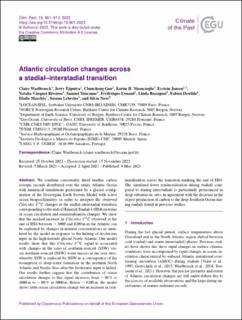| dc.contributor.author | Waelbroeck, Claire | |
| dc.contributor.author | Tjiputra, Jerry | |
| dc.contributor.author | Guo, Chuncheng | |
| dc.contributor.author | Nisancioglu, Kerim Hestnes | |
| dc.contributor.author | Jansen, Eystein | |
| dc.contributor.author | Vazquez Riveiros, Natalia | |
| dc.contributor.author | Toucanne, Samuel | |
| dc.contributor.author | Eynaud, Frederique | |
| dc.contributor.author | Rossignol, Linda | |
| dc.contributor.author | Dewilde, Fabien | |
| dc.contributor.author | Marchès, Elodie | |
| dc.contributor.author | Lebreiro, Susana | |
| dc.contributor.author | Nave, Silvia | |
| dc.date.accessioned | 2023-06-29T12:21:31Z | |
| dc.date.available | 2023-06-29T12:21:31Z | |
| dc.date.created | 2023-06-06T13:14:35Z | |
| dc.date.issued | 2023 | |
| dc.identifier.issn | 1814-9324 | |
| dc.identifier.uri | https://hdl.handle.net/11250/3074362 | |
| dc.description.abstract | We combine consistently dated benthic carbon isotopic records distributed over the entire Atlantic Ocean with numerical simulations performed by a glacial configuration of the Norwegian Earth System Model with active ocean biogeochemistry in order to interpret the observed Cibicides δ13C changes at the stadial–interstadial transition corresponding to the end of Heinrich Stadial 4 (HS4) in terms of ocean circulation and remineralization changes. We show that the marked increase in Cibicides δ13C observed at the end of HS4 between ∼2000 and 4200 m in the Atlantic can be explained by changes in nutrient concentrations as simulated by the model in response to the halting of freshwater input in the high-latitude glacial North Atlantic. Our model results show that this Cibicides δ13C signal is associated with changes in the ratio of southern-sourced (SSW) versus northern-sourced (NSW) water masses at the core sites, whereby SSW is replaced by NSW as a consequence of the resumption of deep-water formation in the northern North Atlantic and Nordic Seas after the freshwater input is halted. Our results further suggest that the contribution of ocean circulation changes to this signal increases from ∼40 % at 2000 m to ∼80 % at 4000 m. Below ∼4200 m, the model shows little ocean circulation change but an increase in remineralization across the transition marking the end of HS4. The simulated lower remineralization during stadials compared to during interstadials is particularly pronounced in deep subantarctic sites, in agreement with the decrease in the export production of carbon to the deep Southern Ocean during stadials found in previous studies. | en_US |
| dc.language.iso | eng | en_US |
| dc.publisher | Copernicus | en_US |
| dc.rights | Navngivelse 4.0 Internasjonal | * |
| dc.rights.uri | http://creativecommons.org/licenses/by/4.0/deed.no | * |
| dc.title | Atlantic circulation changes across a stadial-interstadial transition | en_US |
| dc.type | Journal article | en_US |
| dc.type | Peer reviewed | en_US |
| dc.description.version | publishedVersion | en_US |
| dc.rights.holder | Copyright 2023 the authors | en_US |
| cristin.ispublished | true | |
| cristin.fulltext | original | |
| cristin.qualitycode | 1 | |
| dc.identifier.doi | 10.5194/cp-19-901-2023 | |
| dc.identifier.cristin | 2152250 | |
| dc.source.journal | Climate of the Past | en_US |
| dc.source.pagenumber | 901-913 | en_US |
| dc.relation.project | Norges forskningsråd: 270061 | en_US |
| dc.relation.project | Norges forskningsråd: 325333 | en_US |
| dc.identifier.citation | Climate of the Past. 2023, 19 (5), 901-913. | en_US |
| dc.source.volume | 19 | en_US |
| dc.source.issue | 5 | en_US |

